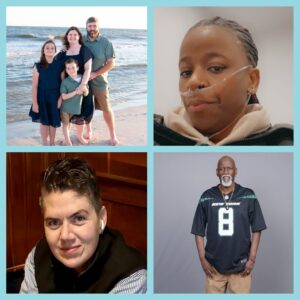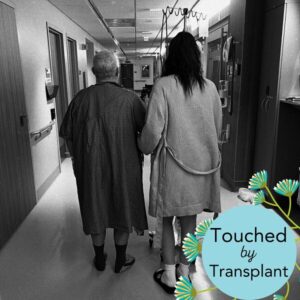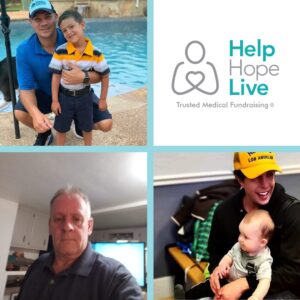Help Hope Live patient Liz Casperite received a kidney transplant with help from living donor Maria Weaver-Hollowniczky in September 2015. The lifesaving gift to fight Liz’s polycystic kidney disease (PKD) cut short her anticipated 5-year wait for a deceased donor kidney. Here’s how Liz has been touched by transplant.
If you are like most people, polycystic kidney disease (PKD) is the most common genetic disease you’ve never heard of. I was diagnosed with PKD in 2004 at age 32. A routine physical found slightly elevated blood pressure. My general practitioner was proactive in ordering additional tests. During the final test, an ultrasound, they found innumerable cysts on my kidneys and liver. Average kidneys are the size of a fist. My kidneys were growing to the size of footballs.

Liz was diagnosed with polycystic kidney disease in 2004
When you have PKD, the veins in your body that help filter blood grow into irregular cysts instead of growing straight. Eventually, blood that gets caught in the cysts and doesn’t filter leads to kidney failure.
After I was diagnosed, I learned that PKD affects more people than sickle cell anemia, cystic fibrosis, muscular dystrophy and down syndrome combined. I also learned that there is no cure for PKD, and that my best chance for a healthy life would be to join the kidney transplant waiting list. I was on the transplant waiting list for two and a half years without getting “the call.”
When I was in renal failure due to PKD, I had very little energy. As my kidney function decreased, I could really only do one activity per day: take a shower, cook, or grocery shop, but not more than that. My kidney function dropped below 20% and I knew I did not have long before my kidneys would fail. More than 10 people were tested to become a living kidney donor for me, but none were approved through the rigorous health testing process.

Once listed, Liz reached out to find a living kidney donor
I got the word out that I needed a living donor using car magnets, t-shirts, and even a sign outside of my house. A friend created a post for me on Facebook and, as friends shared it, a total stranger to me saw it and decided to get tested. That’s how I met my angel, Maria!
After months of testing, we found out that we were a match. I was very fortunate to receive a kidney from a living donor right before I would have had to go on dialysis. Living donor kidneys last almost twice as long as deceased donor kidneys, on average.
Maria hates being called a hero. But she’s reluctantly agreed to the title “superhero” instead! She says that since health was her superpower, she knew she had to share it with others.

Living donor Maria, left, has “reluctantly agreed to the title of superhero”
Many people think transplant is a cure, but really, a transplant is just a treatment for kidney failure. I am fortunate in that my PKD will not attack the new kidney, but I have a polycystic liver that will continue to grow in size and will require additional treatment.
Today, I follow a strict regimen to suppress my immune system to keep the kidney. I take medication every day, exercise and eat a plant-based whole foods diet. Even though I went to physical therapy after the transplant and followed doctor instructions, I got a serious hernia. An operation fixed the hernia but I am now restricted from ever lifting more than 10 pounds. As a treatment, transplantation comes with its own very serious side effects. Being permanently immunosuppressed means being very careful about who I encounter. Even a small cold can negatively affect my new kidney function.

Liz says life after transplant involves permanent lifestyle changes
I still actively fundraise for Help Hope Live. The funds raised in my honor are indispensable for helping me cover the monthly cost of post-transplant medications and trips to and from my transplant center for continuing care.

Liz creates Donor Beads in exchange for donations to Help Hope Live
I am a very active advocate for transplant. I have been lobbying Congress since 2006 to support kidney-related health care legislation. Maria and I were recently in DC to lobby for the Living Donor Protection Act of 2017 to help eliminate barriers to living donation. We volunteer with the National Kidney Foundation, the PKD Foundation and Gift of Life, and we participate in walks and events every year to raise funds and awareness. I have spoken at high schools about kidney disease and we both act as mentors to those starting out the transplant process. There are almost 100,000 people waiting for a kidney in the U.S. and we are passionate about spreading the word to make a difference.

Liz, right, uses every opportunity to advocate for kidney disease patients and donors
My donor, Maria, and I speak to everyone we can about living donation. Maria was inspired to donate a kidney to me because she knew someone who had donated. We hope to be those people for others.

“Kidney sisters” Maria and Liz
 Liz and Maria support transplant candidates and living donors through the Kidney For Liz Facebook page. Liz fundraises for the Mid-Atlantic Kidney Transplant Fund at helphopelive.org.
Liz and Maria support transplant candidates and living donors through the Kidney For Liz Facebook page. Liz fundraises for the Mid-Atlantic Kidney Transplant Fund at helphopelive.org.
Help Hope Live patient Liz Casperite received a kidney transplant with help from living donor Maria Weaver-Hollowniczky in September 2015. The lifesaving gift to fight Liz’s polycystic kidney disease (PKD) cut short her anticipated 5-year wait for a deceased donor kidney. Here’s how Liz has been touched by transplant.
If you are like most people, polycystic kidney disease (PKD) is the most common genetic disease you’ve never heard of. I was diagnosed with PKD in 2004 at age 32. A routine physical found slightly elevated blood pressure. My general practitioner was proactive in ordering additional tests. During the final test, an ultrasound, they found innumerable cysts on my kidneys and liver. Average kidneys are the size of a fist. My kidneys were growing to the size of footballs.

When you have PKD, the veins in your body that help filter blood grow into irregular cysts instead of growing straight. Eventually, blood that gets caught in the cysts and doesn’t filter leads to kidney failure.
After I was diagnosed, I learned that PKD affects more people than sickle cell anemia, cystic fibrosis, muscular dystrophy and down syndrome combined. I also learned that there is no cure for PKD, and that my best chance for a healthy life would be to join the kidney transplant waiting list. I was on the transplant waiting list for two and a half years without getting “the call.”
When I was in renal failure due to PKD, I had very little energy. As my kidney function decreased, I could really only do one activity per day: take a shower, cook, or grocery shop, but not more than that. My kidney function dropped below 20% and I knew I did not have long before my kidneys would fail. More than 10 people were tested to become a living kidney donor for me, but none were approved through the rigorous health testing process.

I got the word out that I needed a living donor using car magnets, t-shirts, and even a sign outside of my house. A friend created a post for me on Facebook and, as friends shared it, a total stranger to me saw it and decided to get tested. That’s how I met my angel, Maria!
After months of testing, we found out that we were a match. I was very fortunate to receive a kidney from a living donor right before I would have had to go on dialysis. Living donor kidneys last almost twice as long as deceased donor kidneys, on average.
Maria hates being called a hero. But she’s reluctantly agreed to the title “superhero” instead! She says that since health was her superpower, she knew she had to share it with others.

Many people think transplant is a cure, but really, a transplant is just a treatment for kidney failure. I am fortunate in that my PKD will not attack the new kidney, but I have a polycystic liver that will continue to grow in size and will require additional treatment.
Today, I follow a strict regimen to suppress my immune system to keep the kidney. I take medication every day, exercise and eat a plant-based whole foods diet. Even though I went to physical therapy after the transplant and followed doctor instructions, I got a serious hernia. An operation fixed the hernia but I am now restricted from ever lifting more than 10 pounds. As a treatment, transplantation comes with its own very serious side effects. Being permanently immunosuppressed means being very careful about who I encounter. Even a small cold can negatively affect my new kidney function.

I still actively fundraise for Help Hope Live. The funds raised in my honor are indispensable for helping me cover the monthly cost of post-transplant medications and trips to and from my transplant center for continuing care.

I am a very active advocate for transplant. I have been lobbying Congress since 2006 to support kidney-related health care legislation. Maria and I were recently in DC to lobby for the Living Donor Protection Act of 2017 to help eliminate barriers to living donation. We volunteer with the National Kidney Foundation, the PKD Foundation and Gift of Life, and we participate in walks and events every year to raise funds and awareness. I have spoken at high schools about kidney disease and we both act as mentors to those starting out the transplant process. There are almost 100,000 people waiting for a kidney in the U.S. and we are passionate about spreading the word to make a difference.

My donor, Maria, and I speak to everyone we can about living donation. Maria was inspired to donate a kidney to me because she knew someone who had donated. We hope to be those people for others.

 Liz and Maria support transplant candidates and living donors through the Kidney For Liz Facebook page. Liz fundraises for the Mid-Atlantic Kidney Transplant Fund at helphopelive.org.
Liz and Maria support transplant candidates and living donors through the Kidney For Liz Facebook page. Liz fundraises for the Mid-Atlantic Kidney Transplant Fund at helphopelive.org.












